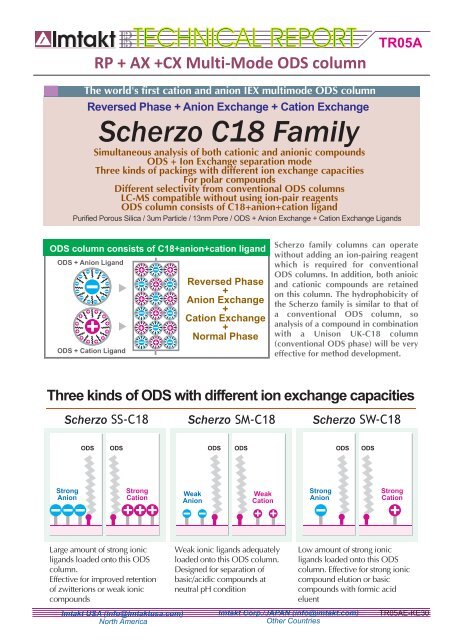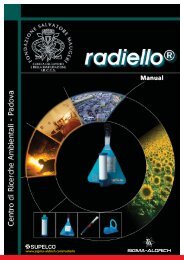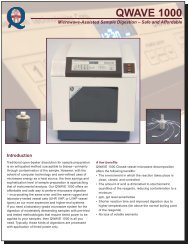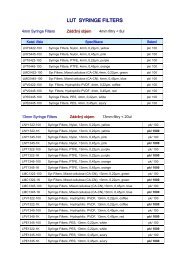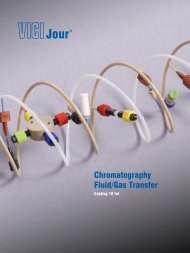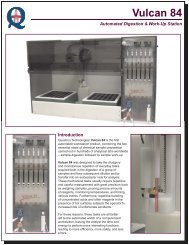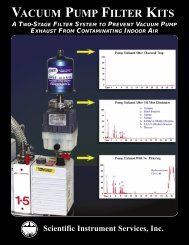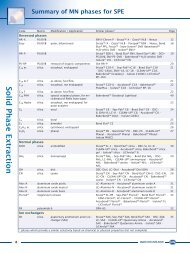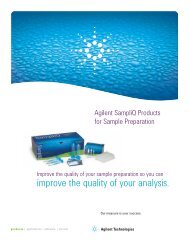Scherzo SM-C18 column applications - Labicom
Scherzo SM-C18 column applications - Labicom
Scherzo SM-C18 column applications - Labicom
Create successful ePaper yourself
Turn your PDF publications into a flip-book with our unique Google optimized e-Paper software.
RP + AX +CX Multi-Mode ODS <strong>column</strong><br />
TR05A<br />
The world's first cation and anion IEX multimode ODS <strong>column</strong><br />
Reversed Phase + Anion Exchange + Cation Exchange<br />
Simultaneous analysis of both cationic and anionic compounds<br />
ODS + Ion Exchange separation mode<br />
Three kinds of packings with different ion exchange capacities<br />
For polar compounds<br />
Different selectivity from conventional ODS <strong>column</strong>s<br />
LC-MS compatible without using ion-pair reagents<br />
ODS <strong>column</strong> consists of <strong>C18</strong>+anion+cation ligand<br />
Purified Porous Silica / 3um Particle / 13nm Pore / ODS + Anion Exchange + Cation Exchange Ligands<br />
ODS <strong>column</strong> consists of <strong>C18</strong>+anion+cation ligand<br />
ODS + Anion Ligand<br />
ODS + Cation Ligand<br />
Reversed Phase<br />
+<br />
Anion Exchange<br />
+<br />
Cation Exchange<br />
+<br />
Normal Phase<br />
<strong>Scherzo</strong> family <strong>column</strong>s can operate<br />
without adding an ion-pairing reagent<br />
which is required for conventional<br />
ODS <strong>column</strong>s. In addition, both anioic<br />
and cationic compounds are retained<br />
on this <strong>column</strong>. The hydrophobicity of<br />
the <strong>Scherzo</strong> family is similar to that of<br />
a conventional ODS <strong>column</strong>, so<br />
analysis of a compound in combination<br />
with a Unison UK-<strong>C18</strong> <strong>column</strong><br />
(conventional ODS phase) will be very<br />
effective for method development.<br />
Three kinds of ODS with different ion exchange capacities<br />
ODS<br />
ODS ODS ODS ODS ODS<br />
Strong<br />
Anion<br />
Strong<br />
Cation<br />
Weak<br />
Anion<br />
Weak<br />
Cation<br />
Strong<br />
Anion<br />
Strong<br />
Cation<br />
Large amount of strong ionic<br />
ligands loaded onto this ODS<br />
<strong>column</strong>.<br />
Effective for improved retention<br />
of zwitterions or weak ionic<br />
compounds<br />
Imtakt USA (info@imtaktusa.com)<br />
North America<br />
Weak ionic ligands adequately<br />
loaded onto this ODS <strong>column</strong>.<br />
Designed for separation of<br />
basic/acidic compounds at<br />
neutral pH condition<br />
Low amount of strong ionic<br />
ligands loaded onto this ODS<br />
<strong>column</strong>. Effective for strong ionic<br />
compound elution or basic<br />
compounds with formic acid<br />
eluent<br />
Imtakt Corp./JAPAN (info@imtakt.com)<br />
Other Countries<br />
TR05AE-KE30
Separation modes of <strong>Scherzo</strong> <strong>C18</strong> <strong>column</strong>s<br />
The <strong>Scherzo</strong> <strong>C18</strong> Family, (SS-<strong>C18</strong>, <strong>SM</strong>-<strong>C18</strong>, SW-<strong>C18</strong>), consists of not only ODS ligands, but also<br />
anion ligands and cation ligands. It also provides reversed-phase mode, both ion exchange modes,<br />
and normal phase mode.<br />
Separation Mode<br />
Reversed-Phase<br />
Stationary Phase<br />
Octadecyl<br />
Properties<br />
Increasing organic solvent composition (decreas<br />
ing porarity of eluent) decreases retention.<br />
Anion Exchange<br />
Cation<br />
Increasing ionic strength (salt or acid concentra<br />
tion) decreases retention for acidic compounds.<br />
Generally, low pH increases retention.<br />
Cation Exchange<br />
Normal Phase<br />
Anion<br />
Anion/Cation<br />
IIncreasing salt concentration decreases retention<br />
for basic compounds. <strong>SM</strong>-<strong>C18</strong> retains more with<br />
increasing pH, while SS-<strong>C18</strong> and SW-<strong>C18</strong> retain<br />
more at lower pH.<br />
Polar solutes which cannot be retained with<br />
100% aqueous eluent may be retained by using<br />
> 50% organic solvent composition due to<br />
electrostatic interaction.<br />
Retention properties of <strong>Scherzo</strong> <strong>C18</strong> <strong>column</strong>s (RP+AX+CX)<br />
Multi-mode ODS <strong>Scherzo</strong> <strong>C18</strong> <strong>column</strong>s consist of ODS ligands which have reversed-phase mode,<br />
plus anion and cation ligands which have anion/cation exchange modes. Three kinds of <strong>Scherzo</strong><br />
<strong>column</strong>s have individual ion exchange capacities to find the best <strong>column</strong> for target compounds<br />
which have different ionic properties. Moreover, hydrophobicity between <strong>Scherzo</strong> <strong>C18</strong> and Unison<br />
UK-<strong>C18</strong>, a conventional ODS, is similar, so these <strong>column</strong>s can be used as comparisons during<br />
method development.<br />
1 2<br />
3<br />
3<br />
1<br />
2<br />
H3C<br />
CH3<br />
+<br />
N CH3<br />
CH3<br />
phenyltrimethylammnonium<br />
(Cation)<br />
SO 3 H<br />
p-toluenesulfonic acid<br />
(Anion)<br />
The entire family, all retain both<br />
basic compounds (1) and acidic<br />
compounds (2).<br />
SS-<strong>C18</strong> shows largest retention,<br />
followed by <strong>SM</strong>-<strong>C18</strong> and then<br />
SW-<strong>C18</strong>. Retention may be<br />
affected by compound dissociation<br />
and mobile phase pH to provide<br />
switched retention.<br />
1 2<br />
3<br />
O<br />
C NH2<br />
benzamide (Neutral)<br />
Non-ionic compounds may be<br />
eluted with similar retention<br />
between these <strong>column</strong>s.<br />
3<br />
1<br />
2<br />
<strong>Scherzo</strong> SS-<strong>C18</strong>, <strong>SM</strong>-<strong>C18</strong>, SW-<strong>C18</strong>, 150 x 3 mm<br />
A: 40 mM ammonium formate<br />
B: 100 mM ammonium formate / acetonitrile = 50 / 50<br />
0 - 100 %B (0 - 15 min), 0.4 mL/min, 37 °C, 260 nm<br />
At neutral pH conditons, SW-<strong>C18</strong> has the least retention<br />
capacity, and <strong>SM</strong>-<strong>C18</strong> and SS-<strong>C18</strong> have stronger retention<br />
power. These retention differences among the <strong>column</strong>s<br />
will be enhanced under lower initial salt concentration.<br />
2
Affecting factors for retention on <strong>Scherzo</strong> <strong>C18</strong> <strong>column</strong>s<br />
You can find the best HPLC conditions by optimizing ionic strength or pH to improve retention /<br />
separation for ionic compounds, which is difficult on a conventional ODS <strong>column</strong><br />
Not only pH but also ionic strength (concentration of salt or acid) will strongly affect the retention on<br />
<strong>Scherzo</strong> <strong>C18</strong> <strong>column</strong>s<br />
This effect is the same as ion-exchange <strong>column</strong>s<br />
<strong>Scherzo</strong> <strong>C18</strong> <strong>column</strong>s, which have RP + both ion exchange modes, require optimization of organic<br />
solvent, pH, and ionic strength<br />
benzenesulfonic acid<br />
(Anion) SO<br />
- 3<br />
<strong>Scherzo</strong> SS-<strong>C18</strong><br />
benzamide (Neutral)<br />
(SS-<strong>C18</strong>, <strong>SM</strong>-<strong>C18</strong>, SW-<strong>C18</strong>)<br />
<strong>Scherzo</strong> <strong>SM</strong>-<strong>C18</strong><br />
<strong>Scherzo</strong> SW-<strong>C18</strong><br />
0 20 40 60 80 100<br />
mM HCOONH4<br />
benzenesulfonic acid<br />
(Anion) SO<br />
- 3<br />
<strong>Scherzo</strong> SS-<strong>C18</strong><br />
<strong>Scherzo</strong> <strong>SM</strong>-<strong>C18</strong><br />
benzamide (Neutral)<br />
(SS-<strong>C18</strong>, <strong>SM</strong>-<strong>C18</strong>, SW-<strong>C18</strong>)<br />
<strong>Scherzo</strong> SW-<strong>C18</strong><br />
2 3 4 5 6 7<br />
pH<br />
phenyltrimethylammnonium<br />
(Cation)<br />
CH3<br />
+<br />
N CH3<br />
<strong>Scherzo</strong> SS-<strong>C18</strong><br />
benzamide (Neutral)<br />
(SS-<strong>C18</strong>, <strong>SM</strong>-<strong>C18</strong>, SW-<strong>C18</strong>)<br />
<strong>Scherzo</strong> <strong>SM</strong>-<strong>C18</strong><br />
<strong>Scherzo</strong> SW-<strong>C18</strong><br />
0 20 40 60 80 100<br />
mM HCOONH4<br />
phenyltrimethylammnonium<br />
(Cation)<br />
CH3<br />
+<br />
N CH3<br />
<strong>Scherzo</strong> SS-<strong>C18</strong><br />
benzamide (Neutral)<br />
(SS-<strong>C18</strong>, <strong>SM</strong>-<strong>C18</strong>, SW-<strong>C18</strong>)<br />
<strong>Scherzo</strong> SW-<strong>C18</strong><br />
<strong>Scherzo</strong> <strong>SM</strong>-<strong>C18</strong><br />
2 3 4 5 6 7<br />
pH<br />
Elution strategies by <strong>Scherzo</strong> <strong>C18</strong> <strong>column</strong>s<br />
Non-ionic<br />
hydrophobic solutes<br />
Ionic<br />
hydrophobic solutes<br />
Weak ionic-polar solutes<br />
Strong ionic-polar solutes<br />
Salt<br />
pH<br />
For the <strong>Scherzo</strong> multi-mode<br />
ODS <strong>column</strong>s, optimizing the<br />
salt concentration is as<br />
important as optimizing the<br />
organic solvent. In the left<br />
figure, retention of both anionic<br />
and cationic compounds are<br />
decreased when salt<br />
concentration is increased. At<br />
the same salt concentration, SS-<br />
<strong>C18</strong>, which consists of a large<br />
amount of strong ionic ligands,<br />
retains strongly. <strong>SM</strong>-<strong>C18</strong> , with<br />
weak ionic ligands has medium<br />
retention. And finally, SW-<strong>C18</strong>,<br />
which has a low amount of<br />
strong ionic ligands, shows the<br />
lowest retention.<br />
pH is also an important factor<br />
for the elution of ionic<br />
compounds. Retention will<br />
change dramatically between<br />
neutral pH (ammonium acetate<br />
or formate) and low pH (formic<br />
acid) conditions. SS-<strong>C18</strong> and<br />
SW-<strong>C18</strong> consist of strong ionic<br />
ligands and retention will be<br />
increased under low pH<br />
conditions. On the other hand,<br />
<strong>SM</strong>-<strong>C18</strong> consists of weak ion<br />
ligands which cannot ionize at a<br />
low pH - therefore, retention of<br />
basic compounds will be<br />
decreased due to a decrease in<br />
ionization capacity at low pH.<br />
Organic solvent composition should be optimized (similar to conventional ODS).<br />
Peak shape is often improved by using 0.1% acetic acid.<br />
A combination of organic solvent and 20-100mM of salt or acid at optimal pH<br />
should be used for separation of both acidic / basic compounds.<br />
SS-<strong>C18</strong> is often the best choice for weak ionic polar solutes. Ionic strength should be<br />
increased for compounds that contain multiple ionic functional groups. Neutral pH<br />
conditions are required for mono-carboxylic acid compounds.<br />
SW-<strong>C18</strong> may be useful when it is difficult to elute on SS-<strong>C18</strong> or <strong>SM</strong>-<strong>C18</strong>. Strong<br />
ionic compounds have strong ionic interaction, so it is recommended to use multiple<br />
gradient elutions with ionic strength and organic solvent composition.<br />
3<br />
CH3<br />
CH3
Mobile phase preparation for <strong>Scherzo</strong> <strong>C18</strong> <strong>column</strong>s<br />
<strong>Scherzo</strong> <strong>C18</strong> <strong>column</strong>s consist of ODS and ionic ligands. At first this new approach is difficult for some<br />
users to conceptualize. However, it is easier to think of the <strong>column</strong>s as an ODS <strong>column</strong> AND an ion<br />
exchange <strong>column</strong>. The following eluent conditions are a rough guideline:<br />
Isocratic Elution<br />
water / acetonitrile / HCOOH = x / y / 0.1 (x+y = 100) Acidic pH Eluent<br />
50mM ammonium acetate / acetonitrile = x / y (x+y = 100)<br />
Gradient Elution<br />
A) water / HCOOH = 100 / 0.1<br />
B) water / acetonitrile / HCOOH = 30 / 70 / 0.5<br />
A) 10mM ammonium acetate<br />
B) 100mM ammonium acetate / acetonitrile = 30 / 70<br />
A) water / HCOOH = 100 / 0.1<br />
B) 100mM ammonium formate / acetonitrile = 30 / 70<br />
Neutral pH Eluent<br />
Gradient with<br />
Acid and Organic Solvent<br />
Gradient with<br />
Salt and Organic Solvent<br />
Gradient with pH,<br />
Ionic Strength,<br />
and Organic Solvent<br />
Comparison of <strong>Scherzo</strong> <strong>column</strong>s: Optimized on SS-<strong>C18</strong> (Neurotransmitter)<br />
Each <strong>Scherzo</strong> <strong>column</strong> has different properties and target compounds depending on <strong>column</strong> choice.<br />
SS-<strong>C18</strong> has strong ionic ligands and is useful for zwitter-ions, as well as for separating weak ionic<br />
compounds.<br />
2<br />
Catecholamines<br />
1<br />
H2N<br />
CH2<br />
CH2<br />
O<br />
C<br />
OH<br />
gamma-aminobutyric acid<br />
(GABA)<br />
3<br />
4<br />
2<br />
HO<br />
HO<br />
HO<br />
CH<br />
CH2<br />
NH2<br />
noradrenaline<br />
(norepinephrine)<br />
1<br />
5<br />
3<br />
HO<br />
HO<br />
HO<br />
CH<br />
CH2<br />
NH<br />
CH3<br />
adrenaline<br />
epinephrine)<br />
1<br />
2<br />
3<br />
4<br />
HO<br />
HO<br />
HO<br />
HO<br />
H2N<br />
CH2 C C OH<br />
CH2<br />
H<br />
CH2<br />
O<br />
dihydroxy-L-phenylalanine<br />
(L-DOPA)<br />
NH2<br />
dopamine<br />
5 150 x 3 mm<br />
A: water / formic acid = 100 / 0.3<br />
B: 100mM ammonium formate / acetonitrile = 70 / 30<br />
0-60%B (0-30 min)<br />
0.4 mL/min (9MPa), 37 °C, ELSD<br />
0 10 20 30 min<br />
4<br />
5<br />
Due to strong ionic ligands, SS-<strong>C18</strong> and SW-<strong>C18</strong> retain more than <strong>SM</strong>-<strong>C18</strong> which has weak ionic<br />
ligands. In particular, SS-<strong>C18</strong> will provide an excellent retention performance for very polar ionic<br />
compounds. Also, SW-<strong>C18</strong>, which interacts weakly with these compounds, may be useful for hightroughput<br />
analysis.<br />
Formic acid is strictly required at initial conditions due to positive ion of GABA, but dopamine has a<br />
stronger interaction under such acidic conditions. Finally, this application is done with a multiple<br />
gradient mode using pH, ionic strength, and organic solvent gradients.<br />
4
<strong>Scherzo</strong> SS-<strong>C18</strong> <strong>column</strong> <strong>applications</strong> (Zwitter-ions)<br />
Zwitter-ions which have internal salt generating iso-electric points (pI) are very polar. While it is<br />
difficult to retain zwitter-ions on a conventional ODS <strong>column</strong>, <strong>Scherzo</strong> SS-<strong>C18</strong> provides very effective<br />
retention ability.<br />
Figure 5a<br />
Zwitter-ions<br />
150 x 3 mm<br />
water / methanol / formic acid<br />
= 98 / 2 / 0.6<br />
0.4 mL/min, 37 °C, ELSD<br />
1<br />
2<br />
HO<br />
H3C<br />
O<br />
P<br />
OH<br />
NH<br />
CH3<br />
N + CH2<br />
CH3<br />
betaine<br />
NH<br />
C<br />
N<br />
CH3<br />
C<br />
CH2<br />
O<br />
O -<br />
O<br />
C<br />
creatine phosphate<br />
OH<br />
0 10 20 min<br />
2<br />
Acidic Eluent, Isocratic<br />
3<br />
4<br />
CH2<br />
H3C N + CH2<br />
CH2<br />
L-carnitine<br />
H<br />
C<br />
OH<br />
CH2<br />
C<br />
O<br />
O -<br />
1<br />
Na +<br />
3<br />
4 5<br />
5<br />
6<br />
creatine<br />
CH3 CH2 NH C<br />
L-theanine<br />
O<br />
CH2<br />
H2N CH2 CH2 CH2<br />
L-ornithine<br />
H2N<br />
H2N<br />
CH2<br />
C<br />
H<br />
C<br />
C<br />
H<br />
O<br />
C<br />
OH<br />
O<br />
OH<br />
0 10 20 min<br />
Figure 5b<br />
2<br />
1<br />
Na+<br />
5<br />
3<br />
4<br />
pH + Ionic Strength +<br />
Organic Solvent,<br />
Multiple Gradient<br />
150 x 3 mm<br />
A: water / HCOOH<br />
=100 /0.3<br />
B: 100mM HCOONH4 /ACN<br />
= 50 / 50<br />
10-30 %B (0-30 min)<br />
0.4 mL/min, 37 °C, ELSD<br />
6<br />
0 10 20 30 min<br />
Zwitter-ions, as typified by amino acids are very<br />
polar and difficult to retain on conventional ODS<br />
<strong>column</strong>s. SS-<strong>C18</strong> which consists of many strong<br />
ionic ligands can retain and separate those<br />
zwitter-ions easily.<br />
Figure 5a shows that SS-<strong>C18</strong> enables sufficient<br />
retention/separation due to ionic interaction<br />
between positive-charged zwitter-ions under<br />
acidic conditions. There are opportunities to get<br />
optimized retention when formic acid or organic<br />
solvent concentration is changed.<br />
Figure 5b shows an example with multiple<br />
gradient elution with pH, ionic strength, and<br />
organic solvent. Zwitter ions are ionized to<br />
positive under acidic condition, so initial eluent<br />
should have low pH conditions. In contrast,<br />
ornithine has another amino group which<br />
provides a positive charge and becomes a strong<br />
cationic compound, so it is difficult to elute under<br />
acidic condition. In this case, neutral pH provides<br />
weak ionic interaction and pH gradient with<br />
increasing of ionic strength and organic solvent is<br />
very effective for elution of ornithine.<br />
5
<strong>Scherzo</strong> <strong>SM</strong>-<strong>C18</strong> <strong>column</strong> <strong>applications</strong> (Salts, Vitamins)<br />
<strong>Scherzo</strong> <strong>SM</strong>-<strong>C18</strong>, consisting of ODS ligands and both weak anion / cation ligands, is useful for a<br />
wide range of ionic compounds such as salts, vitamins, acidic / basic compounds, alkaloids etc.<br />
It is also offers different selectivity from conventional ODS like Unison UK-<strong>C18</strong>.<br />
Simaltanious analysis of salt<br />
1 Organic Salt<br />
pH 2.5<br />
pH 3.5<br />
pH 3.8<br />
pH 4.2<br />
pH 4.7<br />
pH 4.9<br />
pH 5.4<br />
pH 6.4<br />
1<br />
2<br />
2<br />
2<br />
2<br />
1<br />
2<br />
1<br />
0 2 4 6 8 min<br />
1<br />
2<br />
1<br />
1<br />
1<br />
2<br />
2<br />
A: 50mM HCOOH<br />
A: 50mM HCOOH :<br />
50mM HCOONH4<br />
= 6 : 4<br />
A: 50mM HCOOH :<br />
50mM HCOONH4<br />
= 4 : 6<br />
A: 50mM HCOOH :<br />
50mM HCOONH4<br />
= 2 : 8<br />
A: 50mM HCOOH :<br />
50mM HCOONH4<br />
= 1 : 9<br />
A: 50mM HCOOH :<br />
50mM HCOONH4<br />
= 5 : 95<br />
A: 50mM HCOOH :<br />
50mM HCOONH4<br />
= 2 : 98<br />
A: 50mM HCOONH4<br />
532<br />
HO<br />
O<br />
O<br />
1 2<br />
OH<br />
hibenzic acid<br />
Acidic<br />
CH3<br />
<strong>Scherzo</strong> <strong>SM</strong>-<strong>C18</strong>, 50 x 3 mm<br />
A: formate buffer, B: acetonitrile<br />
20-60 %B (0-8min), 0.4 mL/min, 37 °C, 280 nm<br />
N<br />
S<br />
S<br />
tipepidine<br />
Basic<br />
Tipepidine hibenzate, a popular cough medicine,<br />
consists of basic and acidic components.<br />
Conventional ODS <strong>column</strong>s can usually analyze<br />
organic salts, but sometimes there is a problem in<br />
separating other compounds. By changing eluent<br />
pH, one can change elution order (selectivity) on<br />
<strong>SM</strong>-<strong>C18</strong>. When pH is increased, retention of basic<br />
compounds will be increased, while acidic<br />
compounds will be decreased. <strong>SM</strong>-<strong>C18</strong> was<br />
designed to show effective ionic interaction under<br />
neutral pH conditions.<br />
<strong>SM</strong>-<strong>C18</strong> will provide a better solution than<br />
conventional ODS <strong>column</strong>s when solute sensitivity<br />
and separation is required. <strong>SM</strong>-<strong>C18</strong> is available for<br />
not only organic salts but also inorganic salts<br />
separation like NaCl.<br />
Water-fat soluble vitamins<br />
1-B1: Thiamine<br />
2-B8: myo-Inositol<br />
3-B6: Pyridoxine<br />
4-C: Ascorbic acid<br />
5-B5: Pantothenic acid<br />
6-B9: Folic acid<br />
7-B12: Cyanocobalamin<br />
8-B2: Riboflavin<br />
9-B7: Biotin<br />
10-A: Retinol<br />
11-K2: Menaquinone<br />
12-D2: Ergocalciferol<br />
13-D3: Cholecalciferol<br />
14-E: a-Tocopherol<br />
15-K1: Phylloquinone<br />
RT<br />
Minutes<br />
0.92<br />
1.14<br />
1.44<br />
1.94<br />
7.32<br />
9.92<br />
10.17<br />
10.49<br />
10.70<br />
17.64<br />
20.87<br />
22.89<br />
23.26<br />
23.61<br />
25.86<br />
%RSD (n=6) LOD (S/N=3)<br />
RT Response ng (o.c.)<br />
0.11<br />
0.09<br />
0.16<br />
0.25<br />
0.15<br />
0.09<br />
0.11<br />
0.11<br />
0.09<br />
0.06<br />
0.07<br />
0.06<br />
0.06<br />
0.07<br />
0.07<br />
2.6<br />
6.2<br />
2.7<br />
2.4<br />
6.8<br />
3.1<br />
4.1<br />
3.4<br />
4.2<br />
6.7<br />
2.1<br />
1.5<br />
2.6<br />
1.6<br />
1.7<br />
Vitamin Mix<br />
648<br />
<strong>Scherzo</strong> <strong>SM</strong>-<strong>C18</strong>, 150 x 2 mm<br />
3<br />
A: 0.3% HCOOH aq.<br />
1 2<br />
10<br />
B: acetonitrile<br />
7<br />
4 5 89<br />
6<br />
0%B (0-0.1 min)<br />
11<br />
0-30%B (0.1-10 min)<br />
12 14<br />
13<br />
30%B (10-11 min)<br />
30-100%B (11- 12 min)<br />
100%B (12-26 min)<br />
0.3 mL/min, 30°C, 2uL(DMSO soln.)<br />
ELSD (SEDEX 90LT, 40°C, 3.5Bar) 0 5 10 15 20 25 min<br />
5.7<br />
6.3<br />
1.8<br />
9.6<br />
6.9<br />
8.0<br />
4.6<br />
5.0<br />
4.8<br />
1.7<br />
14.2<br />
47.6<br />
52.6<br />
45.0<br />
41.7<br />
Since water-soluble vitamins are hydrophilic and<br />
fatsoluble vitamins are hydrophobic, simultaneous<br />
analysis of both types of vitamins is a very difficult<br />
issue.<br />
<strong>SM</strong>-<strong>C18</strong> succeeds in this application; gradient elution<br />
from acidic pH aqueous conditions to acetonitrile<br />
provides sufficient separation of various 15 vitamins.<br />
D2 and D3 is also separated. Thiamine (basic<br />
compound) and ascorbic acid are both retained as a<br />
multi-mode ODS <strong>column</strong> advantage.<br />
Detecion is done by ELSD in this application, but<br />
there is an opportunity for MS detection due to use of<br />
a volatile mobile phase.<br />
Data provided by Dr. Eric VERETTE, SEDERE S.A.S., France<br />
6<br />
15
<strong>Scherzo</strong> <strong>SM</strong>-<strong>C18</strong> <strong>column</strong> <strong>applications</strong> (Separation Selectivity)<br />
<strong>Scherzo</strong> <strong>C18</strong> <strong>column</strong>s are designed by using the same silica and ODS ligand density as a Unison<br />
UK-<strong>C18</strong> <strong>column</strong>. <strong>SM</strong>-<strong>C18</strong> may be effective in changing selectivity when it is difficult to separate<br />
impurities on an ODS <strong>column</strong>.<br />
1<br />
2<br />
Selectivity<br />
H3C<br />
O<br />
OH<br />
1 2<br />
O<br />
mevalonolactone<br />
HO<br />
H3C<br />
OH O<br />
OH<br />
mevalonic acid<br />
150 x 3 mm<br />
5mM ammonium formate /acetonitrile = 90 /10<br />
0.4 mL/min (10MPa), 37 °C, ELSD<br />
2<br />
0 2.5 5 min<br />
1<br />
<strong>Scherzo</strong> SW-<strong>C18</strong> <strong>column</strong> <strong>applications</strong> (Acidic Compounds)<br />
siRNA Universal<br />
Negative Control<br />
(Manufacturer-S)<br />
Control siRNA<br />
Negative Control<br />
(Manufacturer-C)<br />
Control siRNA<br />
Human beta-actin<br />
(Manufacturer-N)<br />
0 20 40 min<br />
519<br />
<strong>Scherzo</strong> <strong>SM</strong>-<strong>C18</strong> and Unison UK-<strong>C18</strong> are designed in<br />
such a way that they provide similar retention of nonionic<br />
compounds. In addition, <strong>SM</strong>-<strong>C18</strong> can retain both<br />
anionic / cationic compounds under neutral pH<br />
conditions. This means that there is an opportunity to<br />
improve separation on <strong>SM</strong>-<strong>C18</strong> than on a conventional<br />
ODS by only changing <strong>column</strong>s under the same<br />
conditions.<br />
This comparison between <strong>SM</strong>-<strong>C18</strong> and UK-<strong>C18</strong> helps to<br />
determine whether or not an unknown compound is<br />
ionic.<br />
<strong>Scherzo</strong> SW-<strong>C18</strong> includes a few amount of strong ionic ligands which is a novel structural idea from<br />
traditional ion-exchange <strong>column</strong>s. This ssurface structure offers strong ionic compounds elution.<br />
siRNA<br />
Figure 7a<br />
7<br />
<strong>Scherzo</strong> SW-<strong>C18</strong> has a small amount of strong<br />
ionic ligands which is a novel structural idea from<br />
traditional ion-exchange <strong>column</strong>s. This surface<br />
structure provides better elution of strong ionic<br />
compounds.<br />
siRNA (small interfering RNA), around 21mer base<br />
paired double stranded RNA, is getting lots of<br />
attention for next generation medicine. But it is<br />
very polar and has a lot of phosphoric acids<br />
inside, therefore difficult to analyze in RP mode.<br />
Figure 7a on SW-<strong>C18</strong> shows multiple peaks of<br />
commercial siRNA reagents which may include<br />
different structural compounds. SW-<strong>C18</strong> seems to<br />
recognize the different number of nucleic bases<br />
(hydrophobic interaction) and phosphoric acids<br />
(ionic interaction). SW-<strong>C18</strong> may be useful for<br />
structue study of siRNA.<br />
SW-<strong>C18</strong> can separate not only siRNA, but also<br />
ATP or oligo-nucleotides without adding an ionpairing<br />
reagent in the eluent. SW-<strong>C18</strong> is<br />
applicable for strong ionic compounds like<br />
phosphoric compounds because there is a small<br />
amount of ionic ligands on the surface of the<br />
stationary phase.<br />
<strong>Scherzo</strong> SW-<strong>C18</strong>, 150 x 3 mm<br />
A: 10 mM CH3COONH4<br />
B: 200 mM CH3COONH4 / ACN = 85 / 15<br />
0-100%B (0-45 min)<br />
0.4 mL/min (10 MPa), 37 °C, 260 nm
<strong>Scherzo</strong> SW-<strong>C18</strong> <strong>column</strong> <strong>applications</strong> (Drugs, Metabolites)<br />
<strong>Scherzo</strong> SW-<strong>C18</strong> will provide excellent performance for basic drug compounds and ionic metabolites<br />
between low and neutral pH conditions due to a small amount of strong anionic / cationic ligands.<br />
SW-<strong>C18</strong> may be useful for DMPK or metabolome studies.<br />
Various elution conditions for basic drugs<br />
1<br />
2 3<br />
4<br />
Basic Compounds<br />
[1] Acidic pH Conditions<br />
A: water /HCOOH = 100 / 0.5<br />
B: ACN /HCOOH = 100 / 1<br />
20-80%B (0-15 min)<br />
1<br />
2<br />
HO<br />
O<br />
C<br />
HN<br />
H<br />
OH<br />
CCH2NHCH3<br />
HCl<br />
phenylephrine<br />
NHCH2H3CN CH2CH3<br />
CH2CH3<br />
C<br />
O<br />
CH 3<br />
HCl<br />
N-acetylprocainamide<br />
1<br />
2<br />
3<br />
4<br />
[2] Multiple Conditions<br />
A: water /HCOOH = 100 /0.1<br />
B: 100mM HCOONH4 /ACN<br />
= 50 /50<br />
0-100%B (0-15 min)<br />
3<br />
4<br />
O<br />
C<br />
NH2<br />
OCH2CH2N CH2CH3<br />
CH2CH3<br />
CH2<br />
procaine<br />
HCl<br />
HCl<br />
naphazoline<br />
<strong>Scherzo</strong> SW-<strong>C18</strong>, 150 x 3 mm<br />
0.4 mL/min (9 MPa), 37 °C, 260 nm<br />
1<br />
2<br />
0 5 10 15 min<br />
3<br />
4<br />
[3] Neutral pH Conditions<br />
A:10 mM HCOONH4<br />
B:100mM HCOONH4 /ACN<br />
= 50 /50<br />
0-100%B (0-15 min)<br />
There are three basic ways to analyze<br />
basic compounds on <strong>Scherzo</strong> SW-<strong>C18</strong>.<br />
[1] Gradient with formic acid + organic<br />
solvent concentration will retain basic<br />
compounds as strong positive ions.<br />
Various cationic compounds are retained<br />
with initial / final formic acid<br />
concentration.<br />
[2] Gradient between low concentration<br />
of formic acid and high concentration of<br />
its salt with organic solvent may separate<br />
a wide-range of polar and strong cationic<br />
compounds.<br />
[3] Gradient with ionic strength at neutral<br />
pH and organic solvent is a very useful<br />
easy method to analyze both basic and<br />
acidic compounds.<br />
Product Information<br />
Spec.: purified porous silica, 3um particle, 13nm pore, ODS+anion+cation ligand<br />
Column Name Column I.D. Column Length Guard Column<br />
0.075mm - 0.5mm<br />
1mm, 1.5mm, 2mm, 3mm<br />
4.6mm, 6mm, 10mm<br />
10mm, 20mm, 30mm<br />
50mm, 75mm, 100mm<br />
150mm, 250mm, 500mm<br />
Guard Holder<br />
Cartridge Column<br />
Imtakt USA (info@imtaktusa.com)<br />
North America<br />
Imtakt Corp./JAPAN (info@imtakt.com)<br />
Other Countries


